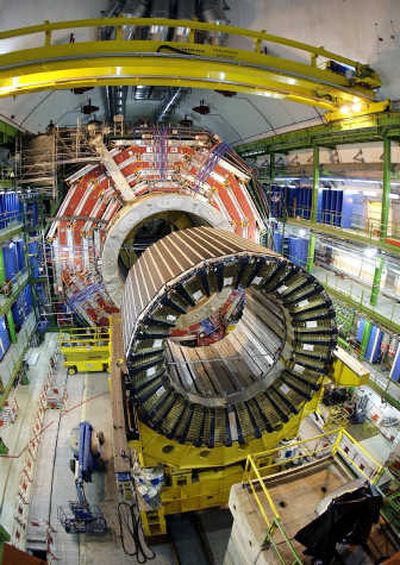Experts attest to safety of smasher

MEYRIN, Switzerland – The most powerful atom-smasher ever built could make some bizarre discoveries, such as invisible matter or extra dimensions in space, after it is switched on in August.
But some critics fear the Large Hadron Collider could exceed physicists’ wildest conjectures: Will it spawn a black hole that could swallow Earth? Or spit out particles that could turn the planet into a hot dead clump?
Ridiculous, say scientists at the European Organization for Nuclear Research, known by its French initials CERN – some of whom have been working for a generation on the $5.8 billion collider, or LHC.
David Francis, a physicist on the collider’s huge ATLAS particle detector, smiled when asked whether he worried about black holes and hypothetical killer particles known as strangelets.
“If I thought that this was going to happen, I would be well away from here,” he said.
The collider basically consists of a ring of supercooled magnets 17 miles in circumference attached to huge barrel-shaped detectors. The ring, which straddles the French and Swiss border, is buried 330 feet underground.
The machine has been called the largest scientific experiment in history. It isn’t expected to begin test runs until August, and ramping up to full power could take months. But once it is working, it is expected to produce some startling findings.
Scientists plan to hunt for signs of the invisible “dark matter” and “dark energy” that make up more than 96 percent of the universe, and hope to glimpse the elusive Higgs boson, a so-far undiscovered particle thought to give matter its mass.
The collider could find evidence of extra dimensions, a boon for superstring theory, which holds that quarks, the particles that make up atoms, are infinitesimal vibrating strings.
The safety of the collider, which will generate energies seven times higher than its most powerful rival, at Fermilab near Chicago, has been debated for years. Physicist Martin Rees has estimated the chance of an accelerator producing a global catastrophe at one in 50 million – long odds, to be sure, but about the same as winning some lotteries.
By contrast, a CERN team this month issued a report concluding that there is “no conceivable danger” of a cataclysmic event. The report essentially confirmed the findings of a 2003 CERN safety report, and a panel of five prominent scientists not affiliated with CERN, including one Nobel laureate, endorsed its conclusions.
Critics of the LHC filed a lawsuit in a Hawaiian court in March seeking to block its startup, alleging that there was “a significant risk that … operation of the Collider may have unintended consequences which could ultimately result in the destruction of our planet.”
On Tuesday, U.S. Justice Department lawyers representing the Department of Energy and the National Science Foundation filed a motion to dismiss the case.
In rebutting doomsday scenarios, CERN scientists point out that cosmic rays have been bombarding the earth, and triggering collisions similar to those planned for the collider, since the solar system formed 4.5 billion years ago.
And so far, Earth has survived.